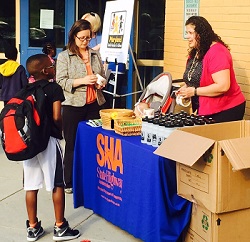Purpose

The Purpose of the Safe Routes to School Projects is:
- to enable and encourage children, including those with disabilities, to walk, roll, and bicycle to school;
- to make bicycling, walking, and rolling to school a safer and more appealing transportation alternative, thereby encouraging a healthy and active lifestyle from an early age; and
- to facilitate the planning, development, and implementation of projects and activities that will improve safety and reduce traffic, fuel consumption, and air pollution in the vicinity of schools.
- to enable and encourage children, including those with disabilities, to walk, roll, and bicycle to school;
- to make bicycling, walking, and rolling to school a safer and more appealing transportation alternative, thereby encouraging a healthy and active lifestyle from an early age; and
- to facilitate the planning, development, and implementation of projects and activities that will improve safety and reduce traffic, fuel consumption, and air pollution in the vicinity of schools.
Background:
On July 6, 2012 MAP-21 (Moving Ahead for Progress in the 21st Century Act) was signed into law. This Act established the Transportation Alternatives Program (TAP). The U.S. Congress passed a new transportation law called the FAST
Act in December 2015, which provides five years of additional funding to the Transportation Alternatives Program (TAP). The updated policy supports walking, bicycling, and rolling projects and programs such as Safe Routes to School.
How the Program Works:
The Safe Routes to School (SRTS) Program is a federal-funded, reimbursement program administered by the Maryland Department of Transportation State Highway Administration (MDOT SHA). Eligible sponsors may apply for funding to support infrastructure and non-infrastructure activities that encourage children to safely walk, bicycle or roll to school. Federal funds allocated to this program must benefit elementary and middle school children in grades K-8 and must have a 20% cash match contribution. Work with your school, community, county and other public or private partners to develop a project today!

Education: educating students, parents and neighbors of safe practices. This includes being aware of each other (neighbor/student, parent/student and neighbor/parent) and adding simple techniques to ensure the safety of those involved.

Encouragement: encouraging the students, neighbors and parents to embrace the idea of SRTS. Provide incentives for students walking, rolling, or biking to school. Host events such as a walking school bus, walking Wednesdays, walking/wheeling Wednesdays bicycle rodeos and bicycle trains. Other encouragement opportunities include events hosted by after school clubs and organizations.

Enforcement: monitoring the areas immediately around the school(s) by issuing tickets and warnings to those who act against the law. In addition, students, parents, community members and crossing guards learn to enforce safety. Law enforcement will monitor volunteers and the wider scope of the schools’ premises.

Engineering: making changes to floating and semi-permanent elements like signage, outdoor furniture, crossing areas, sidewalks, curbs and ramps. These changes slow down traffic, add a safe place for pedestrians and bikers to travel and provide more accessibility for students to get to school.

Evaluation: Observing the area to note the existing conditions. Are the sidewalks in good shape? Are the crosswalks visible? Is there a bike lane? Paying attention to where drop-off/pick-up happens. Is it organized? Is it safe? What is the distance between the drop-off spot and the school's entrance? Watching where students travel. Are they biking, rolling, or walking? Is there a path for them to walk, roll, or bike? Monitoring traffic patterns. How much traffic is there? How fast are the drivers going? Are they driving safely? Are they stopping at Stop signs? Note these observations, whether they are positive or negative. What needs improvement? What is working well?